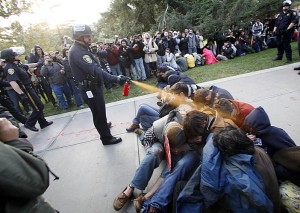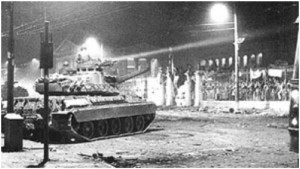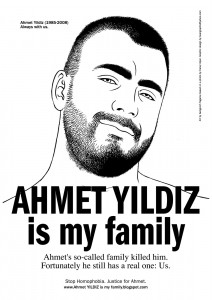There was something missing, something just not right…
Spring Qtr. ’11. A student in my “Human Rights” introductory course was at my office hours to talk. In class we had discussed the human rights implications of the targeted killing of Osama bin Laden, something that had just happened that week, breaking off from the syllabus to think about terrorism as a crime against humanity and revisiting a discussion we had had earlier about how Islamism (like most religious ideologies) tends to deny the very existence of human rights in favor of a more divinely ordained code of ethics and behaviors.
The classroom conversation turned to the question of whether bin Laden’s human rights had been violated or what we had been told had happened was a justifiable and legitimate use of deadly force? I then asked my students to think about what could have been gained by putting him on trial? We had been studying the concept of crimes against humanity trials and I observed that Nazis, Rwandan Genocidaires, and Serbian ultra-nationalists who had done similar or even worse crimes than bin Laden (but not to Americans) had been successfully captured, tried and even some executed. Think “Judgment at Nuremberg.”

Nazi war criminals in the dock at Nuremberg, 1946
My student had come to talk more about that last question. She had lost someone in the Pentagon, and told me that ever since the killing of bin Laden “there was something missing, something just not right,” and when we talked about putting him on trial that that was it.
…
Human rights undergraduates tend to have this kind of thoughtful and reflective approach to history and the present, which is one of the more rewarding aspects of teaching in that field. But her response was particularly so and made me remember something from the very beginning of my career as a teacher.
I am suddenly the expert because I’m the only historian of the Modern Middle East for three Upstate New York counties. A colleague in my department has asked me to lecture at the Elderhostel. Sixty senior citizens sit at circular banquet tables. It’s three weeks since the Events and a few days after George W. Bush first used the phrase “war on terror” in a speech. It was a speech that also included the word “crusade.” I’m giving a talk on popular culture in the Arab world: Umm Kulthum, Rai music, Palestinian graffiti. That’s not what they want to talk about. They want to know about Them, the Muslims, the Arabs, the Enemy who wants to kill Us.
I try to tell them a different story, one about what a marginal figure bin Laden is and how radical Islamism is a cancer over there, too. Then I tell them that we’re not at war. Those who brought down the towers are criminals, mass murderers, who should face the full force of the American justice system. I ask them to remember Timothy McVeigh who was from another Upstate city and how he was caught, tried and convicted. Al-Qaeda is a criminal enterprise, it’s run and funded like one and it can be dismantled like one, it might take time. But just imagine what an elegant statement of what-makes-us-different it would be to perp-walk bin Laden and his crew into the Daniel Patrick Moynihan federal courthouse in Lower Manhattan and have him judged by a jury of 12 tough New Yorkers, convict them and then let them rot at the supermax in Florence, Colorado? Let the world see them for the pathetic, spineless, petty mobsters they are, let them descend into the hell of their own obscurity and be denied the martyrdom they crave, don’t even sentence them to die, just lock the door and throw away the goddamn key.
In 2001 this didn’t go over so well.

Moynihan Court House – site of successful criminal prosecutions of terrorists
I think I was asking too much of them at the time. That moment was infused with panic and fear, and inflamed by an administration that could invoke Pearl Harbor, the Old West and the Clash of Civilizations in a single breath. What I was asking them to consider seemed weak, effete, intellectual and ineffectual. It was us-or-them and some pointy-headed, tweedy moonlighting assistant professor wasn’t going to persuade them to entrust their desire for revenge to the CIA, FBI, lawyers and judges. That any reaction other than war was possible had been crowded out of public consciousness and it is important to recall today how harshly any dissent was dealt with at the time: it was labeled unpatriotic, it was heresy against the memory of the heroes of 9/11; are you one of them?
I don’t claim to have had any idea at the time what would unfold because of the former administration’s decision to invent the “war on terror.” But that choice to do so — and here I want to distinguish between the Events and the American (over)reaction to them — changed the field of Middle East History, my area of expertise, and altered the environment in which the teaching of and research on human rights takes place.
…
The extent of shared humanity
The starting point for my “Human Rights” course is a close examination of the framing of the Universal Declaration of Human Rights in the wake of World War II. The framers of the UDHR — including Eleanor Roosevelt, for whom this blog is named — insisted that the declaration was an expansion to all of humanity of the kinds of rights established in various national compacts and constitutions including the US Bill of Rights.
The reaction to 9/11 called into question how committed Americans are to the universal nature of human rights. This is of course the question raised by the elaboration of a separate legal system outside of US law for the men held at Guantanamo Bay. In the words of Navy lawyer Lt. Cmdr. Charles Swift, who argued the Hamdan vs. Rumsfeld case: “All men have rights, including the right to a trial — a regular trial! The abuse of prisoners indicates that we don’t think detainees are human.” How then to reconcile the preeminent role of American political thought on the universality of human rights with the application of those rights in practice only to US citizens on US soil? As in other historical fields is there an American human rights exceptionalism?
As I teach human rights, I’ve found that it’s easy to get students to support the human rights claims of a Nelson Mandela or a nameless middle-class college student facing a truncheon in Tahrir Square. The true test of our humanity is seeing that humanity in those monsters that live in our midst. In making war, we are asked to temporarily forget the humanity of the enemy; the overreaction to the Events that led us into wars of our own choosing made that forgetting simple and without cost.
Cultures of Impunity
In the Middle East of today or the South America of the late-20th century when those who abuse human rights under the color of authority routinely get away with it, it is said to have created a “culture of impunity.” As we examine how cultures of impunity are addressed and ended, my students can’t help but see clear echoes of that culture in post-9/11 euphemisms like “extreme rendition” and “enhanced interrogation.” As word comes that the CIA rendered suspects unto Libya and a former US vice-president fears arrest as a war criminal, connecting foreign cultures of impunity to a domestic one doesn’t evoke their outrage but reinforces a creeping cynicism. This cynicism is a pendulum swing away from the too credulous attitudes towards authority and the military solution of a half-generation ago among students who were older when 9/11 took place. This cynicism concerns me inasmuch as it doesn’t enjoin action, but rather its reverse and reinforces an even more dangerous sense of alienation from our political structures.
…
This last year, for the first time I found myself having to tell the history of 9/11 to my students in my giant freshman course, “Fundamentalism.” Before then, I had assumed that they “knew” what had happened. When I began teaching that class, my freshmen were 12 years old when 9/11 took place and many do remember it, or at least think they do and could tell stories about watching the towers collapse on televisions rolled into their junior high classrooms. This year’s freshmen were 8 years old when it happened and their memory of the events, if they have any at all, is mediated by what happened after: the Iraq War, the financial collapse, the election of Barack Obama.
Historians sometimes use (and abuse) the concept of historical interruption. The idea is that a society is evolving or moving a certain direction and some event or war or social or economic collapse sidetracks it onto a course (usually bad) it wouldn’t have taken otherwise. The United States and its relationship to human rights seemed to have been moving in a different historical direction before 9/11. The question we’ll need to answer and what I’ll pose to my students for the rest of my career is whether America and Americans are now back on that path?
Further Readings:
Human Rights Watch: United States: Investigate Bush, Other Top Officials for Torture
American Civil Liberties Union: A Call to Courage: Reclaiming our Liberties Ten Years after 9/11











